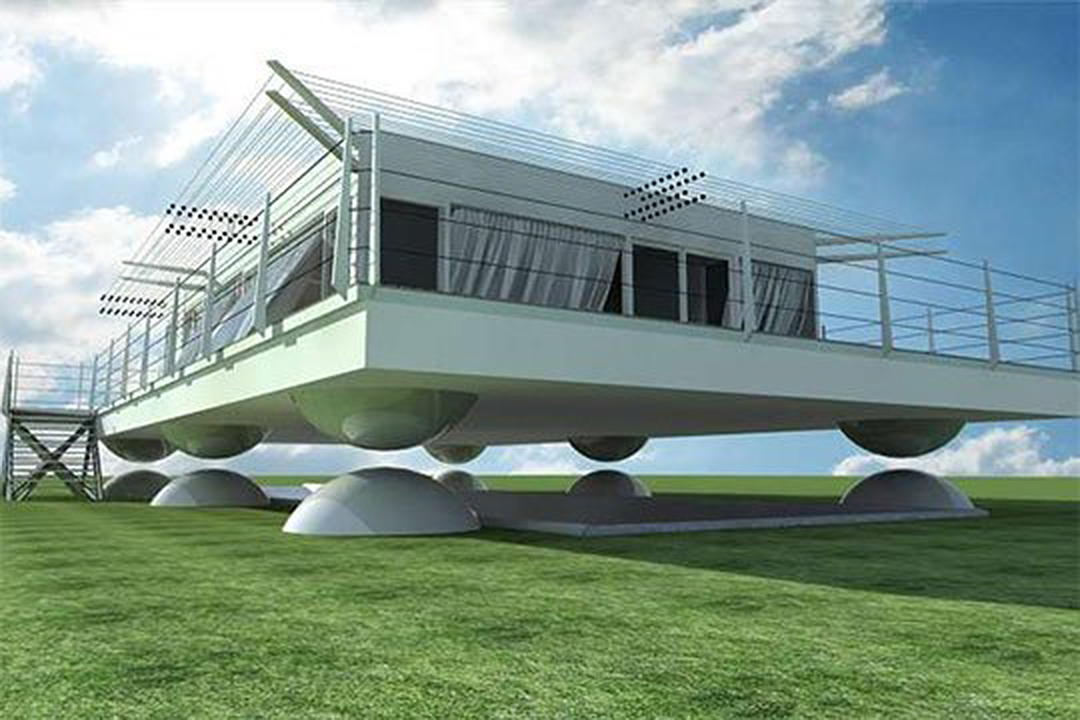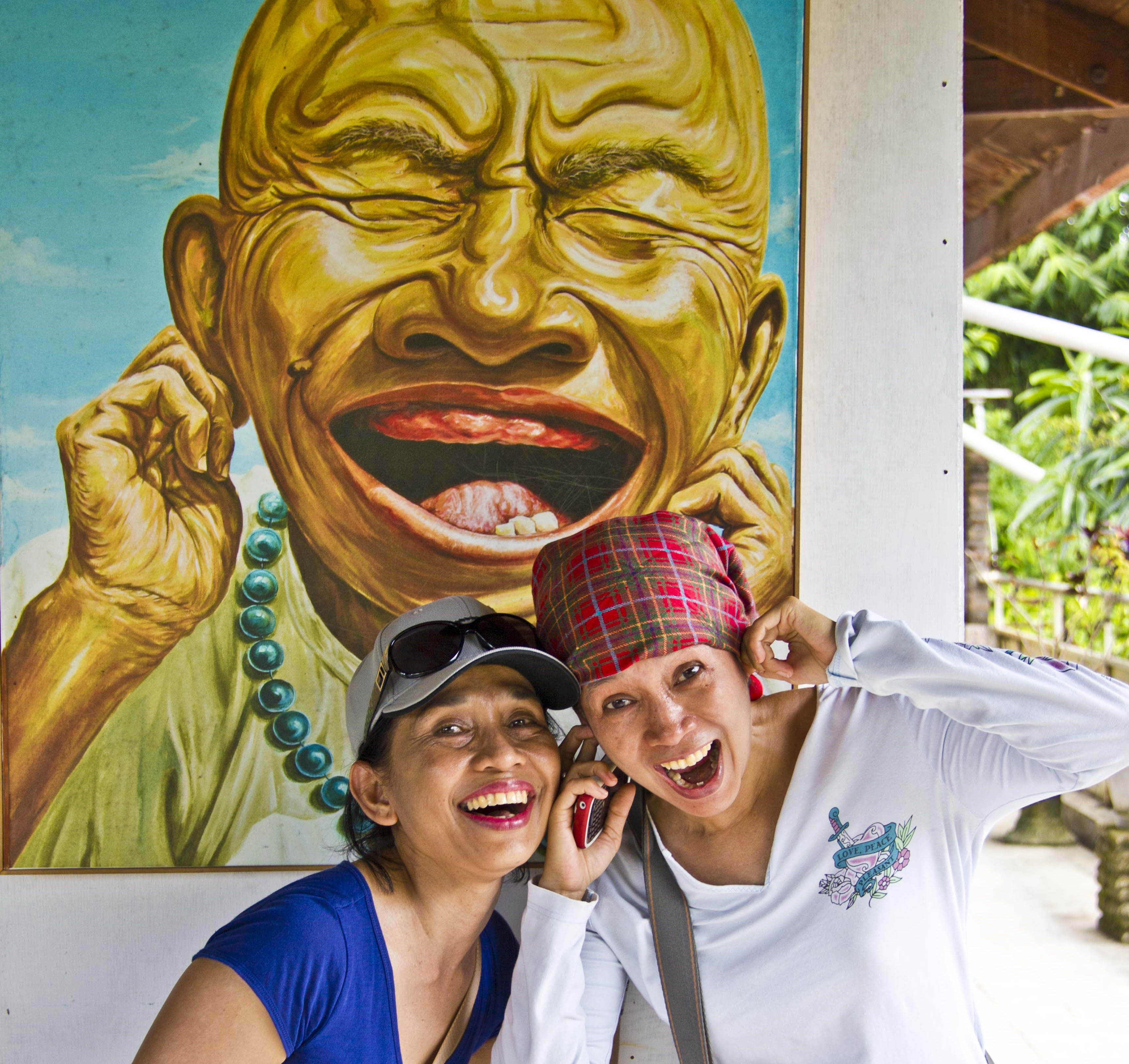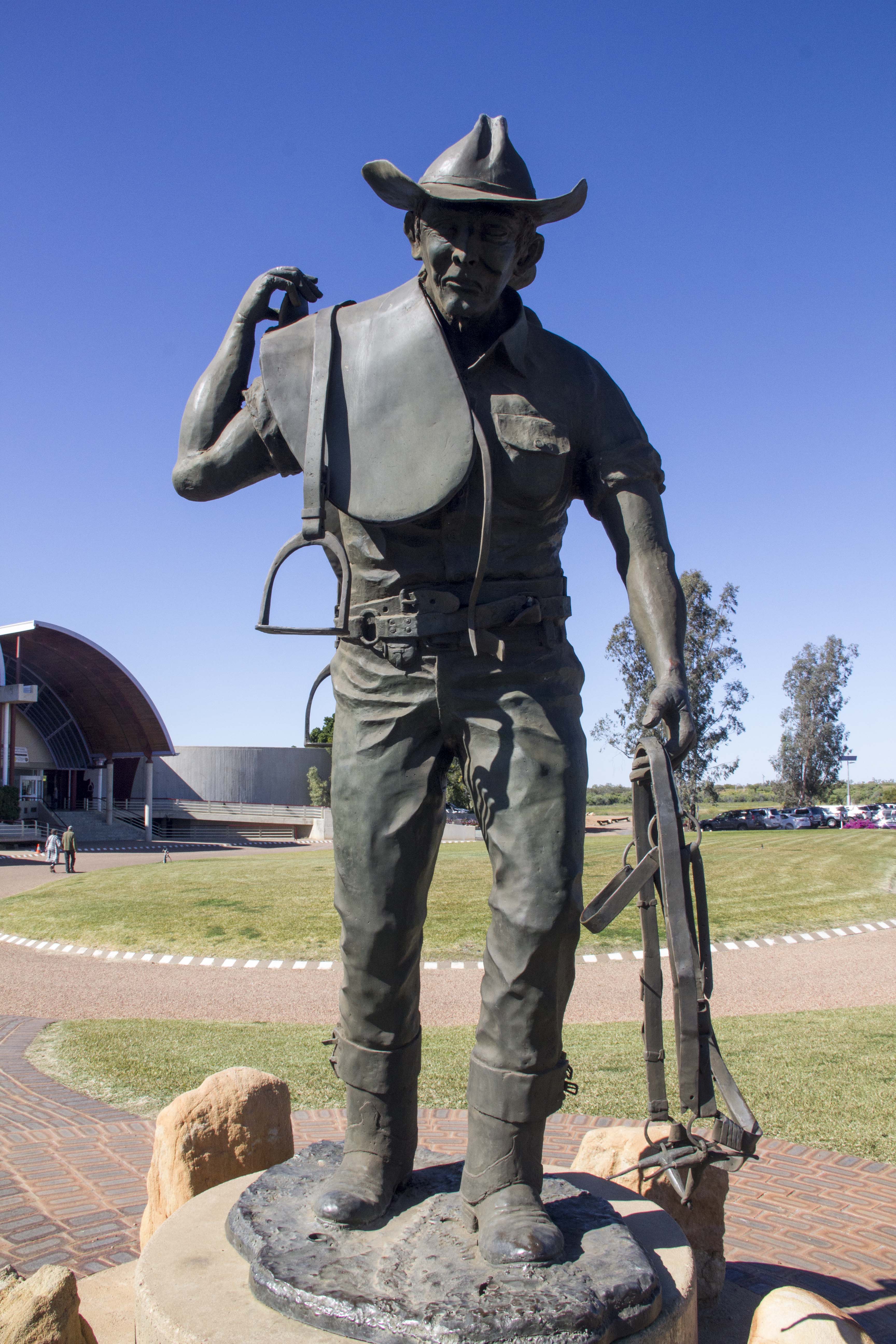Do You Want an Upper or a Downer with That Shake?

The Japanese are seemingly working on a ‘ground-breaking’ solution to prevent earthquake damage to dwellings. Basically, the shaking triggers a sensor that starts a powerful air compressor that elevates the house above its footings. Details appear scant, at least readily available published details, but, in short …
When the footings feel seismic shock shakes,
A compressor by sensor awakes,
As the ground ’celerates,
The house elevates,
To ensure there’s no damage or breaks. 🤗
You can find more, but not much more, on how Japan's Air Danshin is attempting to solve the isolation of structures to seismic shaking, at this link:
https://www.modscape.com.au/blog/japan-earthquake-resistant-buildings-best/
Those of you who love to nitpick and who have a keen eye for detail, however, will notice that the stairs (as currently depicted on the left of the above photo) are connected to both the elevated deck and also the ground. This, of course, is an obvious failing in the concept, as depicted by the artist, unless the stair assembly (including treads, risers, frame and handrails) is constructed of a material with very low elastic modulus (ie capable of effortless stretching) in both horizontal and vertical planes, or includes a flotilla of virtually frictionless piston-cylinder combos, all in mechanical equilibrium, and unaffected by seismic tremors. ‘Artistic licence’ springs to mind, perhaps born of a marketing department and graphic artist's need to display, well in advance of the designer's wish to display?
Then there's the simplistically-shown hemispherical seating arrangements between house and footings, obviously lacking any lateral guides to re-connect the two halves after lateral displacement (again artistic licence kicks in). Is it just me, or is the imagination initially drawn to bra cup sizes for a solution to this one?
But, hey, at this initial theoretical display stage, who gives a hoot about the stairs, and who gives two hooters whether the solution to the footings cup connections lies with Calvin Klein, Berlei or Bendon? Presumably the conquering of such devils, along with a choice of many forks in the road to success, will be in the detail?
It appears to me that achieving a solution to actually elevating the dwelling by concentrations of compressed air, without sending into orbit any peripheral items (such as grandad having a siesta in a hammock on the balcony), might be a much more important devil to dwell on.
Might be worth keeping a lookout for the beta version of this ‘outside the box’ concept. After all, those cunning Japs have a certain reputation for providing resilience to earthquakes in the design of their buildings and structures (see link below).
https://www.planradar.com/gb/japan-earthquake-proof-buildings/
This reputation arises, no doubt, as a consequence of being located firmly on the Pacific Ring of Fire, and having acceptance and application of the following historical concepts:
- Strong Regulation;
- Innovation; and
- Investment.
For those of you with an appetite for examples of seismic resilience design features, which have been adopted by the Japanese in their buildings, the above ‘planradar’ link indicates that their
"… architects may pick and choose between many other earthquake proof building features including:
- The use of a steel frame in the building’s core – as opposed to the reinforced concrete core common in Western structures
- The use of diagonal dampers, steel beams and columns rather than concrete columns
- Pendulums in the core or on the roof of the building
- Dampers installed between the levels of the building
- Mesh structures to help to fortify the building
- Made-to-break T-joints
- Many new buildings are also connected to the country’s early warning system, which alerts inhabitants of an oncoming quake
- Use of fall-away doors which provide more ways to escape
- Covered lights to protect people in case light bulbs explode."
Mater artium necessitas?

...................<<..................>>...................

When not researching the weird or the wonderful, the comical or the cultured, the sinful or the serious, I chase my creative side, the results of which can be seen as selected photographs of my travels on my website at:
https://ken-boddie.squarespace.com
The author of the above, Ken Boddie, besides being a sometime poet and occasional writer, is an enthusiastic photographer, rarely leisure-travelling without his Canon, and loves to interact with other like-minded people with diverse interests.
Ken's three day work week (part time commitment) as a consulting engineer allows him to follow his photography interests, and to plan trips to an ever increasing list of countries and places of scenic beauty and cultural diversity.
#earthquakeresilience #japanesebuildings #seismicdesign #floatingbuilding
Designin Café beBee and in 2 more groups
Articles from Ken Boddie
View blog
Today is, believe it or not, ‘National Let’s Laugh Day’ in the USA? But why shouldn't we all take a ...

There's a part of Australia I've seen now and then, · Where the folks are resilient, both women and ...

It was hot … bloody hot! … yet here we were in the middle of the 'high dune' country, in the south o ...
Related professionals
You may be interested in these jobs
-
Retail Specialist
Found in: Talent AU C2 - 3 hours ago
Tom Ford Melbourne, Australia Part timePosition Summary: · As one of our talented sales advisors you will provide welcoming, authentic and personalized service to our customers in order to achieve all customer service and sales targets. With your passion for people; our company; products and services, you will ensure ...
-
Lifestyle Assistant
Found in: Talent AU C2 - 2 days ago
Arcare Aged Care Epping, Australia Part timeLIFESTYLE ASSISTANT | ARCARE CIVIC MANOR · Permanent Part Time Position- 75hours per fortnight · Monday to Friday 09.00am to 5.00pm · Cert IV Leisure & Health (Preferred, not essential) · Preferably experienced in same field · Promotes and Supports a Healthy Work-Life Balance · ...
-
Loan Set Representative
Found in: Talent AU C2 - 2 days ago
Zimmer Biomet Mildura, Australia ExternalJOB DESCRIPTION At Zimmer Biomet, we believe in pushing the boundaries of innovation and driving our mission forward. As a global medical technology leader for nearly 100 years, a patient's mobility is enhanced by a Zimmer Biomet product or technology every 8 seconds. · As a Zim ...




Comments
🐝 Fatima G. Williams
1 year ago #26
#26 Thank you Ken I'll check them out.
Ken Boddie
1 year ago #25
If you would like to learn more about the Japanese, @🐝 Fatima G. Williams , I suggest that you consider a short holiday there. Japan is a country with a very polite culture and cherry blossom season is about to start. You may also wish to look at my previous posts on Japan here:
https://au.bebee.com/producer/gourmand-bankruptcy-in-osaka
https://au.bebee.com/producer/did-we-miss-cherry-blossom-season
https://au.bebee.com/producer/the-discreet-enigmatic-and-evasive-geisha
Ken Boddie
1 year ago #24
Your comment is indeed a succinct summary of my post and links, @Javier 🐝 CR . You are correct in that the technology being explored by Air Danshin is not brand new. I have tried, however, to obtain updates on this general compressed air process during the formulation of my post, but have been unsuccessful to date. I remain optimistic, however, that this concept may actually 'get off the ground'. 🤣😂🤣
🐝 Fatima G. Williams
1 year ago #23
@Ken Boddie what a fascinating share. Happy 2023. I must confess I did not know that the Japan were world-renowned for its earthquake-proof buildings. I learn a lot about country when I meet people as I'd like to understand where they are coming from. Now when I think of all the people I've spoken to, I wonder how I missed the Japanese and there are many of them in Dubai. And you had me laugh out loud at the bra cups imagination and I'm sure its not just you 🤣alot of inspiration and many inventions have dwelled from the opposite sex, it goes both ways I guess 😆
Javier Cámara-Rica 🐝🇪🇸
1 year ago #22
The information provided in the text appears to be mostly accurate, although I tried to find alternative information about it. Should be noted that it is based on a news article from several years ago and there may have been updates or changes to the technology since then.
The concept of using compressed air to elevate a house during an earthquake is known as "Air Danshin" and has been developed in Japan. The system relies on sensors that detect seismic activity and activate air compressors that lift the house off its foundation, isolating it from the shaking of the ground. While the system has not been widely adopted, it has been tested in laboratory and field settings and has shown promising results in reducing damage from earthquakes.
The text also discusses some of the limitations and potential issues with the system, such as the connection of the stairs to both the elevated deck and the ground. These are valid points that should be considered in the design and implementation of the system.
The text also mentions other earthquake-resistant building features that are commonly used in Japan, such as steel frames, diagonal dampers, and pendulums. These features are designed to absorb and dissipate the energy of seismic waves and prevent damage to the building. Japan has a long history of designing and constructing earthquake-resistant buildings due to its location on the Pacific Ring of Fire, where earthquakes and other natural disasters are common.
Overall, the text provides a general overview of the Air Danshin system and some of the challenges and considerations associated with it. It also highlights some of the other earthquake-resistant building features that are commonly used in Japan.
Ken Boddie
1 year ago #21
@Javier 🐝 CR perhaps read this https://au.bebee.com/producer/east-or-west-what-s-Msajzhdii2vS for a comparison of eastern and western cultures?
Javier Cámara-Rica 🐝🇪🇸
1 year ago #20
you are probably right considering my lack of knowledge about japan!!! thank you!
Pascal Derrien
1 year ago #19
All of them I would say things all ok in Eire
Ken Boddie
1 year ago #18
I can’t agree with you there, @Javier 🐝 CR I have also been to Japan and have worked with Japanese engineers In the Middle East and in New Zealand. Some of their solutions, which I have seen first hand in Japan, for stabilising slopes against earthquake-induced landslip, are first rate. They also have a good reputation for earthquake resistant structural engineering. Perhaps this compressed air elevation concept may currently appear far fetched but, based on performance to date … watch this space! 🤔
Javier Cámara-Rica 🐝🇪🇸
1 year ago #17
I like Japanese madness, but as I have been there and they are such different people, both socially and culturally, many of their ideas surely have no place in the western world.
Ken Boddie
1 year ago #16
Hey, @Pascal Derrien , as I said to @Javier 🐝 CR below, is your “Wow” for the architect’s concept, the illustrator’s imagination (but lack of technical awareness), my post, or for MacGyver being the owner of a Swiss army penknife? 😂🤣😂
BTW how's things in the Emerald Isle?
Pascal Derrien
1 year ago #15
Woow thats something else
Ken Boddie
1 year ago #14
Certainly sounds interesting, @Franci 🐝Eugenia Hoffman , but it won’t be “amazing “ until Air Danshin actually get the concept to work. 🤔
Ken Boddie
1 year ago #13
I can always rely on you, @Lada 🏡 Prkic , to open links.
Lada 🏡 Prkic
1 year ago #12
Back to the topic, I opened two links in your post. :) Ancient Japanese builders and architects showed real ingenuity with the design principle of the wooden pagoda at Horyuji Temple and its core pillar with flexible wooden joints to help the structure absorb seismic energy. The pagoda survived many serious earthquakes over 1,300 years and has never collapsed.
Lada 🏡 Prkic
1 year ago #11
I was stunned by the information I found that more than a third of buildings in Turkey were not built in line with legal regulations. The Turkish government legalised all buildings built illegally under the building amnesty in 2019 despite the warning of the profession that it can endanger lives.
Ken Boddie
1 year ago #10
My understanding, @Lada 🏡 Prkic , is that, in Turkey, they have the regulations and the knowledge but there is a lack of enforcement. Unfortunately, it takes such a disaster as we are now seeing before the scale of such disregard for regulations becomes evident on a large scale, along with the implicit callous corruption.
Lada 🏡 Prkic
1 year ago #9
And yes, necessity is indeed the mother of inventions, as the Japanese prove.
Lada 🏡 Prkic
1 year ago #8
Ken, your article took me back to beBee. :) I've been absent for a while.
Everything that engineers, architects and scientists do to make buildings withstand earthquakes is essential—even such a technically vague concept. Thousands killed in the recent earthquake in Turkey and Syria show how poor building standards lead to large-scale tragedy and colossal loss of life.
Jerry Fletcher
1 year ago #7
#6What a vision!
Ken Boddie
1 year ago #6
Well, @Jerry Fletcher …
If all of our houses could fly,
And soar, as we wished, way up high,
With such levitation,
Across every nation,
We’d have traffic jams up in the sky.
Ken Boddie
1 year ago #5
Hi, @Greg Rolfe …
When I write posts my principal aim,
Is to first, above all, entertain,
With the odd simple pun,
We can all have some fun,
Many thanks, Greg, and please come again.
Jerry Fletcher
1 year ago #4
“Come Fly with me, let's fly away” is the lyric this photo brings to mind. Here on the other side of the ring of fire the solutions are much more plebian and nearly impossible to retrofit.
Greg Rolfe
1 year ago #3
A rather curious article. Your assessment of the illustration is accurate and intertaning. Thank you.
Ken Boddie
1 year ago #2
Tell me, @Javier 🐝 CR , is your “Wow” for the architect’s concept, the illustrator’s imagination (but lack of technical awareness), my post, or for MacGyver being the owner of a Swiss army penknife? 😂🤣😂
Javier Cámara-Rica 🐝🇪🇸
1 year ago #1
Wow !